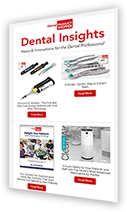Most dental practices rely on vinyl polysiloxane (VPS) impression materials for fabricating prosthetic appliances and indirect restorations. While digital impressions have become increasingly common, conventional impression materials still play an essential role—especially in cases with subgingival crown margins or bleeding areas that are difficult for intraoral scanners to capture accurately. With a wide variety of options on the market, many clinicians gravitate toward fast-setting formulations to reduce chair time, improve patient comfort, and streamline workflow efficiency.
In this case, a VPS impression for a zirconia full-coverage crown was made using Patterson’s super-hydrophilic Reflection impression material in both heavy- and light-body formulations. The material’s short 1 minute 30 second setting time delivered a precise result, supporting a successful restorative outcome. It also exhibited excellent tear resistance upon removal, allowing clear visualization of the preparation margins.
Patient’s Health and Dental History
A 71-year-old man presented to our clinic with a fractured upper right first molar and cold sensitivity. A clinical examination showed an existing large MOB and OL amalgam restoration with clinical decay and fracture of the MB cusp (Figure 1). Percussion testing was negative, and cold testing was positive and lingered for 7 to 10 seconds. Radiographically, there was recurrent decay in the mesial, close to the pulp (Figure 2). Given the above findings, the diagnosis was recurrent decay, fracture, and symptomatic irreversible pulpitis. The treatment plan included caries control to determine restorability, followed by endodontic treatment and delivery of a full-coverage restoration.
Due to the deep decay in the mesial, we informed the patient that the tooth might require a gingivectomy with a laser for proper debridement. When a deep margin is involved, capturing the digital impression can be challenging due to the increased scan depth. Therefore, we selected Reflection VPS impression material for this clinical case.
Preparation for a Full-Coverage Crown
The patient was anesthetized with 2 carpules of 2% lidocaine with 1:100,000 epinephrine. The existing amalgam and caries were removed, and the site was cleaned with 0.12% chlorhexidine, rinsed with water, and dried. A cavity liner was then applied and light-cured for 40 seconds using the Patterson LED Curing Light.
The tooth was prepared for core buildup using a flowable, dual-curing core material. A selective etch was performed with 37% phosphoric acid for 20 seconds, followed by a water rinse. Primer and bond were applied and light-cured for 20 seconds. The build-up material was dispensed in bulk and light-cured for 40 seconds. Finally, the tooth structure was prepared with proper occlusal, axial, and proximal reductions.
Captuing the Impression with Reflection
We used the double-cord technique to achieve a precise impression (Figure 3). After packing both cords, retraction caps were placed over the tooth to enhance gingival retraction and promote hemostasis. A waiting period of 5 minutes was observed to allow for adequate tissue displacement. Since the distal margin was placed deeply, the PS impression technique was selected over a digital impression. The second cord was then carefully removed, and the impression was taken immediately after.
Our assistant dispensed the heavy-body impression material directly into a dual-arch, double-bite tray. While the heavy-body impression was loading on the dual-arch tray, the light-body material was injected into the gingival sulcus, around the finish line, and over the prepared tooth structure. The loaded tray was then seated onto the repared tooth area and removed 3 minutes later. After removing the impression from the patient’s mouth, we were able to see well-defined and accurate margins (Figure 4). Since the Reflection material was able to fully capture the preparation margins and emergence profile, we did not need to do a laser gingivectomy.
The patient expressed satisfaction, noting that the impression procedure was significantly shorter than his previous experiences. The reduced setting time combined with the high tear resistance of the Reflection material minimized chair time and material waste, while facilitating a successful outcome.
Final Results
The dental lab poured the models, digitized the impression, designed the crown, and sent us the STL files for 3D printing in the office. We used SprintRay’s MIDAS to 3D print the crown with an FDA-approved ceramic resin material; post-processing protocols were followed to polish and glaze the restoration (Figure 5).
In the meantime, the patient received endodontic treatment on this tooth, followed by obturation of the minimally invasive access. Dual-cure resin cement was used to bond the restoration after verifying fit, shade, and esthetics with the patient (Figures 6-7). The patient left in great condition and good spirits, noting his appreciation for our efficient practice workflows and increased comfort due to the materials and technology used during treatment.









